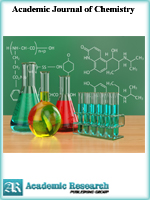Academic Journal of Chemistry
Online ISSN: 2519-7045
Print ISSN: 2521-0211
Print ISSN: 2521-0211
Quarterly Published (4 Issues Per Year)

Archives
Volume 5 Number 2 February 2020
Isolation of Antisnake Venom Agents from Azadirachta Indica (A. Juss) Leaf Extracts
Authors: Ibrahim Sani ; Rabi’u Aliyu Umar ; Sanusi Wara Hassan ; Umar Zaki Faruq ; Fatima Bello
Pages: 10-16
DOI: doi.org/10.32861/ajc.52.10.16
Abstract
Phytochemicals with protein binding properties, active against snake envenomation such as flavonoids, polyphenols, saponins, tannins, terpenoids, xanthenes, quinonoids, steroids and alkaloids bind to toxic venom proteins thereby inactivating them. This research was aimed at isolating antisnake venom agents from Azadirachta indica leaf extracts using activity-guided isolation protocols. A. indica leaf was collected, authenticated and extracted using methanol followed by solvent-fractionation using hexane and ethylacetate. These fractions were further separated using column and thin-layer chromatography. The pooled chromatographic fractions were screened for the antivenom activity using Naja nigricollis venom phospholipase A2 (NVPLA2) inhibition assay and albino rat models. Polyvalent serum-based antivenin was used as standard. The column chromatography of the A. indica leaf hexane and ethylacetate extracts yielded sixty (60) and sixty nine (69) fractions. Based on similarities on the TLC profiles, fractions were pooled. Eleven (11) pooled hexane fractions (PHFs) and fourteen (14) pooled ethylacetate fractions (PEFs) were obtained. After antivenom activity screening, pooled hexane fraction 3 (PHF3) and pooled ethylacetate fraction 1B (PEF1B) from the hexane and ethylacetate fractions respectively protected envenomed albino rats from death at a dose of 20 mg/kg b.w. against 0.8 mg/kg b.w. of N. nigricollis venom. Hence, these findings suggest that the isolated active compounds can serve as leads for the development of safe, readily available and affordable plant-based antivenoms.



